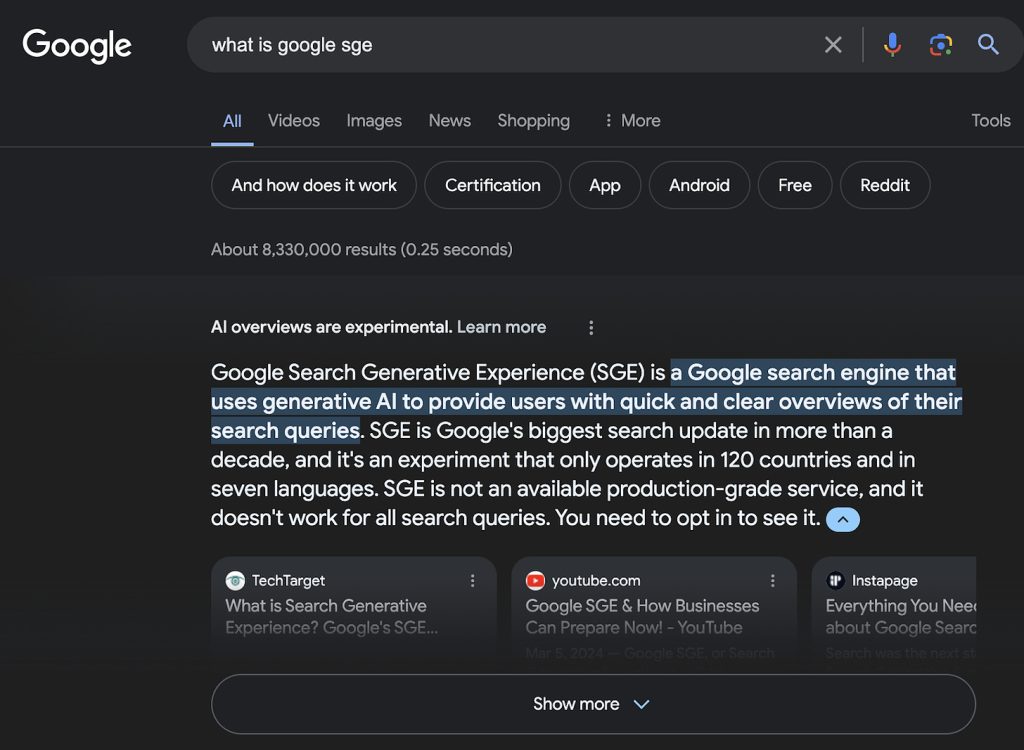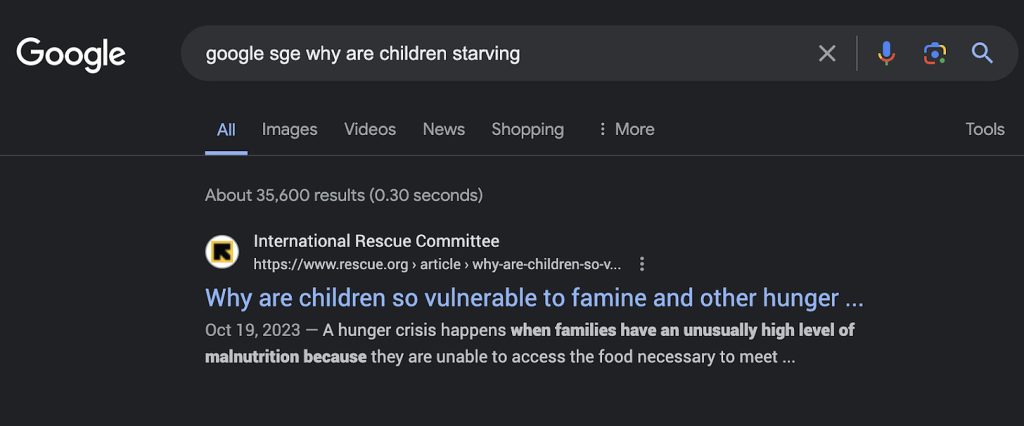
How to Prep for an SGE-Driven Search Experience
Google’s HUGE update to the Search Engine Results Page, named Search Generative Experience (SGE), will have a ginormous impact on how nonprofit’s approach SEM, SEO, and Branding Campaigns.
This isn’t a technical Search Engine post. I’ve tried to keep it practical and included recommendations.
What is SGE? A summary of all the results available on the SERP (search engine results page), put together by AI and placed right at the top of the search results page. It usually looks like this:

The SGE-generated snippet can be expanded, usually includes up to 8 links selected by Google for the user to learn more, and sometimes provides the functionality for the user to ask a follow-up question.
Even though SGE is supposed to be in Beta and only enabled for those who opted in for the Google Search Experiment Labs, you can try it out by adding “Google sge” to most search queries if you haven’t seen it before.
Let’s explore how this update will impact the donor’s search experience, how it will impact your approach to SEO, SEM, and Digital Marketing, and then what you should be doing to prepare for an SGE-driven search experience.
How will it Impact the Donor’s Search Experience?
SGE is in its early days of maturity and will evolve drastically over the following months and years, but 3 things are safe to say:
- AI-generated search experiences are here to stay. Gone are the days of “ten blue links” and paid ads on top of them. Users are looking for simplified experiences, gladly taking one paragraph of text answering their question or one product recommendation instead of a list of options.
- SGE pushes Ads down the page. Despite a couple of examples where this is not the case, for most of us, SGE means the ads will be pushed down, leading to fewer impressions, clicks, and site visits.
- Websites included in the SGE summaries will reap the rewards. The 8 websites included in the “learn more” links are guaranteed to receive more organic traffic than anybody else.
There’s much to learn about SGE – check out Bright Edge’s technical guide on how SGE works for the user and SE Ranking’s snippet research, which covers the SGE experience among 100,000 handpicked keywords.
How will it Impact your SEO, SEM, and Digital Marketing?
With evolving user experiences, Orgs’ search channel performance must follow. A few facts stand out so far from the SE Ranking’s research I shared above:
- 64% of the analyzed keywords already have an SGE answer or a Generate button, and this number will undoubtedly rise to above 90% by the end of 2024.
- 85.5% of SGE snippets link to one or more domains from the top 10 organic results, proving that good SEO “today” will give a head start to organizations “tomorrow” as SGE gets out of beta and user adoption increases.
- Quora.com, local.google.com (Google Maps), and en.wikipedia.org are the most linked domains in SGE, highlighting that locational (Maps) and contextual (Quora, Wikipedia) relevance and depth of content will be the name of the game.
- Long-tail keywords are more likely to trigger AI-powered responses, further amplifying the importance of educational content. This behavior is very similar to what we already see with Voice SEO that I discussed in SPN #59.
- In 27% of cases, no ads accompanied SGE snippets, and in 73%, ads were present. This means a minimum 27% reduction in SEM traffic is coming. This number will likely end up even higher because of users who never scroll down to ads even when they are present. Knowing Google’s unwillingness to reduce its revenue, it’s also safe to assume the remaining clicks will be more expensive.
- SGE experience includes text links, YouTube videos, images, and Product recommendations. The number and type of SGE-included elements are bound to expand, but the evidence is clear that visual content will remain important.
How to Prepare for an SGE-driven Search Experience?
- Produce lots – LOTS – of educational content and landing pages. With SGE adoption increasing, landing page relevancy to the long-tail, conversational keywords will likely become extremely important. Websites will be fighting for inclusion in 8 magical “learn more” links and concepts that used to be typical for paid search ads – answer the question, match the keyword – will migrate to landing pages.
Long-tail keywords tend to be less inclined to generate immediate donations. They should be considered as “Branding campaigns”, introducing prospective donors to the Org when they’re only researching causes close to their heart. Hot take: SEO will become an essential part of the Branding budget.
There’s no good way to test it now but one example can be checking your most important keywords by adding “google sge” – whether it triggers the experience or not is secondary. In the below example, IRC is well-positioned to be included in the SGE summary for opt-in users:

- Invest in Video content and a YouTube channel. Org’s not present on YouTube will miss out on a huge chunk of traffic. YouTube videos are already a significant part of Google’s Search Results page, but given the likely decline in paid clicks on Google.com, it’s safe to assume Google will push even more than needed video results into SGE – moving users to YouTube and further monetizing them.
- For Orgs, it presents an opportunity – and a need – to produce more video content about its impact that users will likely click on.
- Get your Technical SEO ducks in a row. Machines work based on instructions, and large language models – such as the one behind SGE – are not exceptions. Regardless of how much content you have on your website, it must be readable by the machine for SGE to “get” it, score it, and include it in its summary. If your website doesn’t yet include Schema Markup, it will remain a mystery to SGE.
- If your Org has physical products – you’re starting from pole position. I mentioned that Shopping Ads are the only ad type that appears above the SGE summary. Assets such as charity: water store, St. Jude Gift Shop, or UNICEF Inspired Gifts, will be the only ones that qualify for the Paid Product promotion – allowing these Orgs to ingest themselves into the search flow above everyone else. Shopping Ads are hard to make work profitably. If I had physical products at my disposal I’d start playing with Shopping Ads now.
- Finally, start experimenting early. As a nonprofit operator, tap your curiosity and sign up for the Experiment Labs for Google Search – here are the steps – and explore the following →
- Create a list of non-branded keywords that are most important for your Org’s paid search program. I’d aim for those that drive more than 1% of revenue each.
- Set aside ~$100 a month from your paid media budget.
- Create a new Google Ads campaign called something like “SGE Experiments.”
- Target the above keywords and limit the targeting to your Org’s staff members as much as possible – using geo-targeting, interests (here is how you can see yours, in Google’s definition), and any other relevant parameters.
- Turn on the Incognito mode and set aside 15 minutes daily to see how your ads appear for the above keywords with SGE enabled to avoid unpleasant surprises and be ready early.
- Experiment with ad copy, landing pages, and YouTube content – immediately see the changes in experience.
SGE is new and it’s here to stay. It will have a profound impact on SEM and SEO performance for your Org’s Digital Fundraising. Orgs who experiment and learn with it quickly will come out ahead, and considerably improve both brand and fundraising performance.